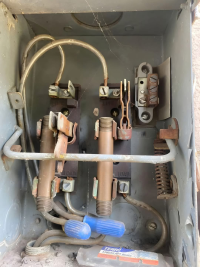-
Welcome to The Building Code Forum
Your premier resource for building code knowledge.
This forum remains free to the public thanks to the generous support of our Sawhorse Members and Corporate Sponsors. Their contributions help keep this community thriving and accessible.
Want enhanced access to expert discussions and exclusive features? Learn more about the benefits here.
Ready to upgrade? Log in and upgrade now.
You are using an out of date browser. It may not display this or other websites correctly.
You should upgrade or use an alternative browser.
You should upgrade or use an alternative browser.
What Amperage Are These Fuses
- Thread starter jar546
- Start date
steveray
SAWHORSE
2000A
tbz
SAWHORSE
Depends, is that standard oxidation or some type of fused coating? 
Paul Sweet
SAWHORSE
As many amps as you want them to be.
wwhitney
REGISTERED
If we assume that the pipe shown is 1/2" schedule 40 brass, then it has an OD of 0.840" and an ID of 0.622". So the cross sectional area is pi/4 * (.840^2-0.622^2) = 0.250 in^2. A cmil is pi/4 square mils, so that's 318,716 cmils.
A random web page claims lead free brass has an electrical conductivity of 28% IACS (copper = 100%), so the resistance per unit length would comparable to 89,240 cmils copper wire. That's between #1 AWG copper (83690 cmils) and #1/0 (105600 cmils).
Another random web page claims the fusing current for #1 copper is 1594A, and for #1/0 copper is 1897A. Now the rate of heat generation in the pipe for a given current will be comparable to 89240 cmil copper wire (ignoring skin effect, which may or may not be valid), but the brass pipe has different thermal characteristics from the equiresistant copper wire. The density and heat capacity are close, but the brasss weight is 3.57 times higher (slower to warm up, but won't affect equilibrium temperature directly), while the outer diameter is greater (more area to radiate heat, so lower equilibrium temperature for a given input heating rate).
The upshot is that I'll guess it's 1500A-2000A, but it could be higher due to the greater surface area. Obviously this is pretty rough, especially the last paragraph above.
Cheers, Wayne
A random web page claims lead free brass has an electrical conductivity of 28% IACS (copper = 100%), so the resistance per unit length would comparable to 89,240 cmils copper wire. That's between #1 AWG copper (83690 cmils) and #1/0 (105600 cmils).
Another random web page claims the fusing current for #1 copper is 1594A, and for #1/0 copper is 1897A. Now the rate of heat generation in the pipe for a given current will be comparable to 89240 cmil copper wire (ignoring skin effect, which may or may not be valid), but the brass pipe has different thermal characteristics from the equiresistant copper wire. The density and heat capacity are close, but the brasss weight is 3.57 times higher (slower to warm up, but won't affect equilibrium temperature directly), while the outer diameter is greater (more area to radiate heat, so lower equilibrium temperature for a given input heating rate).
The upshot is that I'll guess it's 1500A-2000A, but it could be higher due to the greater surface area. Obviously this is pretty rough, especially the last paragraph above.
Cheers, Wayne
Mr. Inspector
SAWHORSE
They forgot the ground
steveray
SAWHORSE
Wow...And I didn't even do math....The upshot is that I'll guess it's 1500A-2000A, but it could be higher due to the greater surface area. Obviously this is pretty rough, especially the last paragraph above.
My father had a project that incorporated copper pipe as a conductor. Water was circulated in the pipe to control the temperature.If we assume that the pipe shown is 1/2" schedule 40 brass
Gregg Harris
SAWHORSE
All this time I thought I was the only one take the time to make the calculations. Great job. Looking at the age, this was pre-lead-free.
Scipio
REGISTERED
If we assume that the pipe shown is 1/2" schedule 40 brass, then it has an OD of 0.840" and an ID of 0.622". So the cross sectional area is pi/4 * (.840^2-0.622^2) = 0.250 in^2. A cmil is pi/4 square mils, so that's 318,716 cmils.
A random web page claims lead free brass has an electrical conductivity of 28% IACS (copper = 100%), so the resistance per unit length would comparable to 89,240 cmils copper wire. That's between #1 AWG copper (83690 cmils) and #1/0 (105600 cmils).
Another random web page claims the fusing current for #1 copper is 1594A, and for #1/0 copper is 1897A. Now the rate of heat generation in the pipe for a given current will be comparable to 89240 cmil copper wire (ignoring skin effect, which may or may not be valid), but the brass pipe has different thermal characteristics from the equiresistant copper wire. The density and heat capacity are close, but the brasss weight is 3.57 times higher (slower to warm up, but won't affect equilibrium temperature directly), while the outer diameter is greater (more area to radiate heat, so lower equilibrium temperature for a given input heating rate).
The upshot is that I'll guess it's 1500A-2000A, but it could be higher due to the greater surface area. Obviously this is pretty rough, especially the last paragraph above.
Cheers, Wayne
That was a lot of brain work, but it was also hella funny.
Andy.


